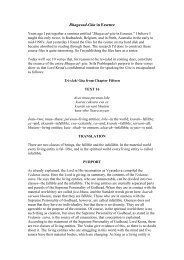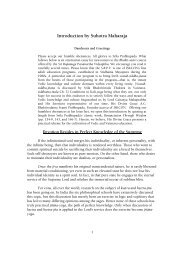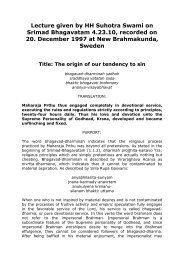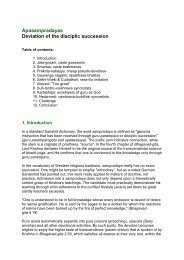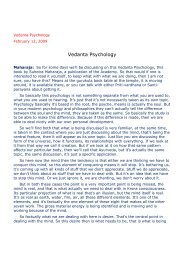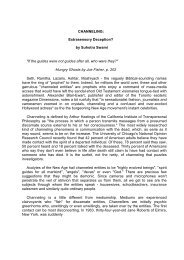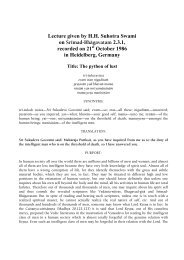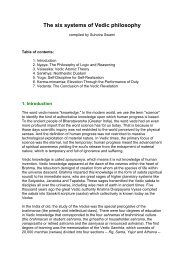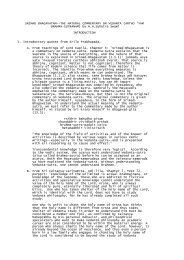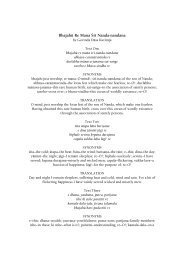What The Upanisads Teach.pdf - Suhotra Maharaja Archives
What The Upanisads Teach.pdf - Suhotra Maharaja Archives
What The Upanisads Teach.pdf - Suhotra Maharaja Archives
Create successful ePaper yourself
Turn your PDF publications into a flip-book with our unique Google optimized e-Paper software.
this story, Isopanisad offers no blessings to tyagis or bhogis: "<strong>The</strong>re is no alternativeto this way for man. " In all that one does, one should be a worshiper of the Lordand thus sacrifice (sacer facere) everything for His sake. One should shun artificialrenunciation--which means accepting less than the Lord offers in this life with a viewto increasing one's quota in the next life. One should shun unrestricted sensegratification--which means taking more than the Lord allows. One's aim should notbe personal satisfaction in this life or the next, but the satisfaction of the Lord.<strong>The</strong> sadhana that engenders brahma-vidya (knowledge of Brahman) is, according tothe upanisads, a method of seeing the Lord, hearing the Lord, thoughtfullyconsidering Him, meditating upon Him, worshiping Him, and performing all activitiesfor Him. It is given the name adhyatma-yoga in Katha Upanisad (I. 2. 12):adhyatma-yogadhigamena devam matva dhiro harsa-sokau jahati--"the wise manleaves behind both joy and sorrow by realizing God through adhyatma-yoga. "Adhyatma means "transcendental. " In Bhagavad-gita 10. 32 Sri Krsna tells Arjunathat He is adhyatma-vidya, the culmination of all Vedic knowledge in realization ofthe transcendental nature of the individual self and the Supreme Self. In explainingthis adhyatma-yoga, Katha Upanisad offers an example upon which Srila Prabhupadaexpounds in his purport to Srimad-Bhagavatam 7. 15. 41:For a bewildered person in the materialistic way of life, the body, the mind and thesenses, which are engaged in sense gratification, are the cause of bondage torepeated birth, death, old age and disease. But for one who is advanced in spiritualknowledge, the same body, senses and mind are the cause of liberation. This isconfirmed in the Katha Upanisad (1. 3. 3-4,9) as follows:atmanam rathinam viddhisariram ratham eva cabuddhim tu sarathim viddhimanah pragraham eva caindriyani hayan ahurvisayams tesu gocaranso 'dhvanah param apnotitad visnoh paramam padam<strong>The</strong> soul is the occupant of the chariot of the body, of which the driver is theintelligence. <strong>The</strong> mind is the determination to reach the destination, the senses arethe horses, and the sense objects are also included in that activity. Thus one canreach the destination, Visnu, who is paramam padam, the supreme goal of life. Inconditioned life the consciousness in the body is the cause of bondage, but the sameconsciousness, when transformed into Krsna consciousness, becomes the cause forone's returning home, back to Godhead.<strong>The</strong> human body, therefore, may be used in two ways--for going to the darkestregions of ignorance or for going forward, back home, back to Godhead.It seems unnecessary to make a wordy argument that this adhyatma-yoga of theKatha Upanisad is bhakti-yoga and not some other type of yoga. <strong>What</strong> other yogacould adhyatma-yoga be? This is a yoga that involves senses, mind and intelligenceas well as the soul. <strong>The</strong> example of riding in a chariot demands of us anunderstanding that adhyatma-yoga involves activity, going from one place toanother, not self-restrained quietude and staying in the same place. <strong>The</strong> unequivocal45



